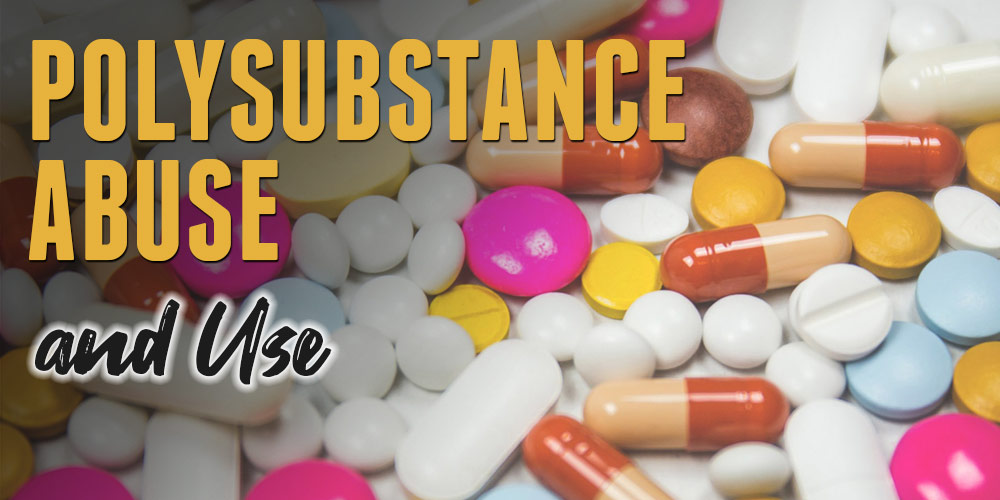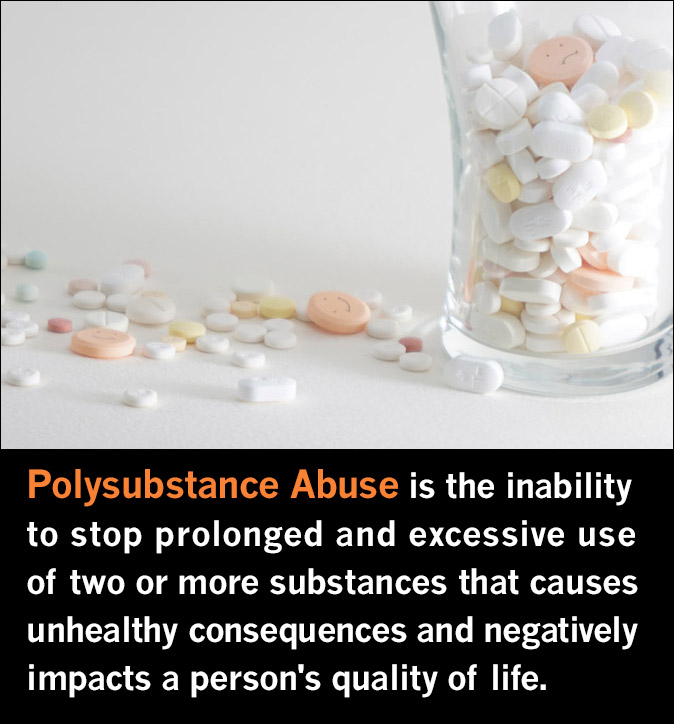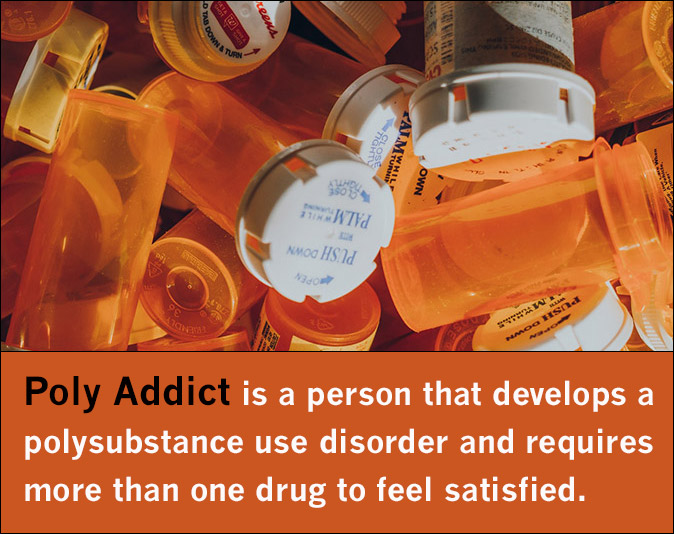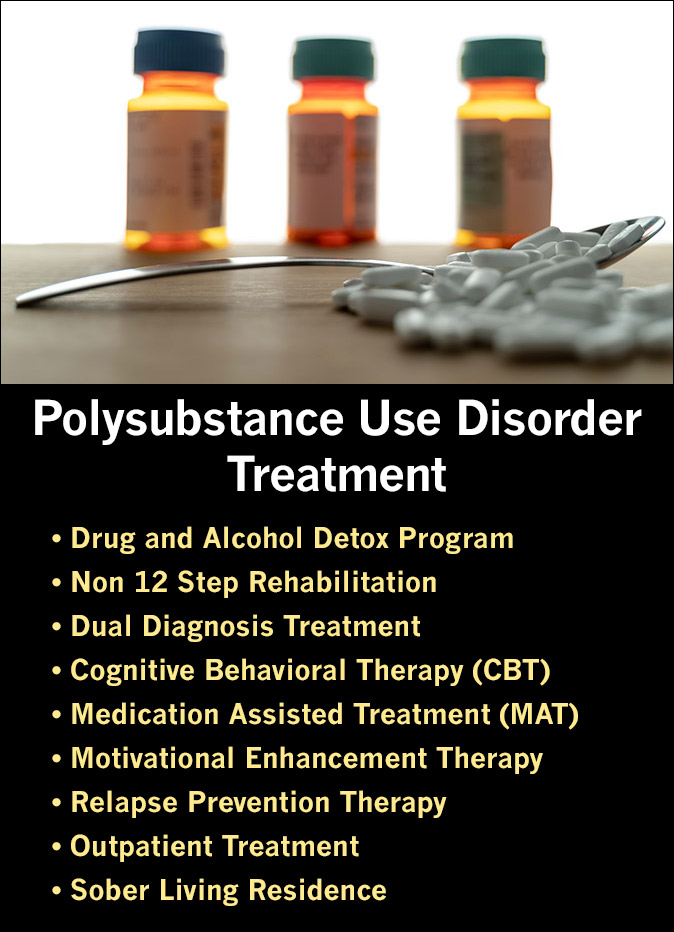
Polysubstance Abuse, or using more than one drug at a time, is increasingly common. The average adult in the United States is taking 4 medications at any one point in time.
So it’s not surprising that 2 million serious adverse drug reactions (ADRs) occur every year in the U.S. – resulting in 106,000 deaths annually from polysubstance use by prescription medications alone, according to the FDA.
While doctors can often determine the effects of two or more drugs interacting with each other in most people, patients often self-medicate or combine alcohol – which can lead to serious drug interactions.
The FDA states, “ADRs are one of the leading causes of morbidity and mortality in health care.”
Adverse drug reactions are also a problem for people who are using non-medication substances and illegal drugs.
It’s important to examine both medical and non-medical polysubstance abuse and poly addiction to identify appropriate treatment options.
What is Polysubstance Use?
Polysubstance use refers to the use of two or more substances at any one time. These substances can be medical or non-medical, including alcohol and illegal drugs.
Many times, polysubstance use is seen as harmless and normal, such as when a person on antidepressants is also taking painkillers. Drinking alcohol while taking prescription medications can sometimes lead to adverse drug reactions.
Polysubstance is different than polypharmacy issues related to taking multiple medications prescribed by a doctor. They share some similarities of taking multiple substances together, although the reasons for taking them are different.
Medically necessary surgeries, chronic illness, and accidents can lead people to routinely reach for painkillers, and over time they can find themselves addicted to them along with other substances they have been taking at the same time.
People can develop a physical or psychological dependence to taking more than one drug because they build up a tolerance to each one. This can inadvertently be the beginning of Polysubstance abuse.

When Does it Become Polysubstance Abuse?
Polysubstance Abuse is formally known as Polysubstance Use Disorder, and it sometimes begins innocently when taking medications as directed.
As time goes by, the dependance to more than one drug can lead to reaching for substitutes if the regular medication or drugs are not easily available.
Polysubstance abuse becomes a problem when a person is unable to stop using the combination of drugs or alcohol that causes unhealthy consequences and negatively impacts their quality of life.
People who suffer from polysubstance use disorder crave the altered state that is produced from taking more than one drug at any given time.
The numbing effect or “high” that is desired can be achieved from taking a variety of drugs, and invariably people who suffer from polysubstance abuse don’t mind what drugs they take.
As long as they get the feeling (or absence of feeling) that they’re craving, it doesn’t really matter to them what it takes to achieve the effects.
The term “crossfaded” is a form of polysubstance use that refers to combining alcohol and marijuana to feel drunk and high at the same time.
Polysubstance abuse differs from alcohol dependency or a single drug addiction by the simple fact that more than one substance is misused.
What is a Poly Addict?
An alcohol-dependent person will routinely rely on alcohol, and a heroin addict will seek out heroin.
In contrast, a poly addict is a person that develops a polysubstance use disorder and requires more than one drug to feel satisfied.

Using multiple drugs at the same time is more dangerous than only using one. It can have serious adverse effects, not just on the person’s health, but also on all aspects of their life.
A poly addict will reach for another substance when they develop a tolerance to the drug they were originally using in an attempt to reach the altered state they desire.
If they can’t find their preferred drug of choice, they will substitute any drug they can find, if it serves the purpose of making them feel good.
Examples of Non-Prescribed Polysubstance Abuse
- Heroin and Methamphetamine
- Heroin and Cocaine (Speedball)
- Benzodiazepines and Alcohol
- Opiates and Amphetamines
- Xanax with Alcohol
- Cocaine and Alcohol
- Adderall and Weed
In recent years since the opioid epidemic began, using a stimulant drug such as cocaine or meth in conjunction with heroin has become common to offset the sluggish effects of the opioids, which is one reason the use of both drugs is increasing.
Polysubstance Abuse Diagnostic Criteria
The Diagnostic and Statistical Manual of Mental Disorders (DSM-5) is used by psychiatrists to diagnose addiction and other mental health conditions.
Polysubstance abuse or polysubstance use disorder was included in the DSM-IV as dependence on 3 or more drugs but was removed in the DSM-5 and is now classified as substance use disorder, regardless of the number of substances involved.
Substance Use Disorder is diagnosed through an assessment based on a scale of severity and the number of symptoms across several categories including impairment, dependence, social problems, and risky use.
Some of the symptoms include:
- Increasing tolerance
- Withdrawal symptoms
- Loss of control
- Inability to stop using, despite the desire to do so
- Increase in the amount of time spent getting drugs, using them, being under the influence, and recovering from use
- Interference with activities that don’t involve drug use
- Harm to self or others

Polysubstance Use Disorder Treatment
Before treating any patients for substance use disorders, it’s necessary they undergo diagnostic tests, including an assessment for underlying mental health disorders.
If a person has a co-occurring mental illness, then the recovery path can differ and dual diagnosis treatment is required.
In most cases, the individual will usually begin the first stage of treatment with detoxification to ween off the substances and manage the side effects of the withdrawal process in a healthy manner.
A drug and alcohol detox program is often required under close medical supervision to ensure the patient is safe and comfortable during withdrawal from all substances.
Detox usually takes a week to 10 days to complete in most circumstances.
There are endless combinations of substances, mental health issues, and personal circumstances that can interact, which makes treatment a very individualized process.
Medical intervention is often required when a person is struggling with polysubstance abuse.
Like addiction to one type of drug or alcohol, polysubstance use disorder treatment uses the same therapies and treatment modalities that have shown to be successful for single substances.
Polysubstance Abuse Treatment Approaches
- Drug and Alcohol Detox Program
- Non 12 Step Rehabilitation
- Dual Diagnosis Treatment
- Cognitive Behavioral Therapy (CBT)
- Medication Assisted Treatment (MAT)
- Motivational Enhancement Therapy
- Trauma Therapy
- Relapse Prevention Therapy
- Outpatient Treatment
- Sober Living Residence
After detoxification and treatment is complete, the real work of recovery begins. There are often deep underlying issues to contend with, and these can be mental or physical in nature. The feelings are often triggered by external environmental circumstances.
A person in recovery needs to use the tools learned during treatment to cope with life stressors, avoid triggers and cravings, and prevent relapse.
It’s never too late to get help for polysubstance use or abuse, although seeking treatment early at the first sign of a problem will offer the best chance for a successful recovery.
Frequently Asked Questions
What is the definition of Polysubstance Use Disorder?
Polysubstance Use Disorder is defined as the inability to stop prolonged and excessive use of two or more substances that causes unhealthy physical, mental, and social consequences, and negatively impacts a person’s quality of life.
What are common polysubstance abuse symptoms?
Polysubstance abuse symptoms affect a person’s physical, psychological, and behavioral health and include some of the following:
- Tolerance to substances used
- Withdrawal symptoms after stopping use
- Heart rate and blood pressure changes
- Problems with work, school, and personal relationships
- Increased risky behaviors
- Mood swings
- Anxiety and depression
- Avoiding people and activities once enjoyed
- Obsessive amount of time spent on acquiring substances
- Unable to stop using substances despite negative consequences
Why was polysubstance abuse removed from the DSM-5?
The DSM-5 focuses on a more comprehensive approach of substance use than previous versions and changed the diagnostic criteria based on each substance individually according to the symptoms and severity.
It also prefers the term ‘substance use disorder’ instead of ‘abuse’ because it is less stigmatizing.
How does polysubstance use disorder differ from single-substance addiction?
Polysubstance use disorder differs from a single substance use disorder in the effects of the drugs, the diagnostic criteria, and the treatment approach.
The effects of alcohol or one drug are much easier to diagnose and treat because the mechanism of action is less complex than the combined effects of two or more substances.
The symptoms of multiple substances are typically more severe and amplified than a single substance, and more unpredictable. This can also lead to more extreme mental health conditions.
This not only complicates a diagnosis but also treatment options, especially detoxification.
Related Posts
- 8 Famous People Who Kicked Their Cocaine Addiction
People are often influenced by the rich and famous, and sadly that can mean normalizing…
- Alcohol Dementia Causes, Symptoms and Treatment
Note: Alcohol Dementia goes by many names including, alcohol-related dementia, alcoholic dementia, and alcohol-induced dementia.…
- 10 Questions to Ask When Searching for Addiction Rehab
Searching for the perfect addiction rehab can be overwhelming for most people. Whether you’re searching…
